“These 13 producers are making a splash in the home market and, increasingly, abroad with a wide range of wines from a big number of varieties, suggesting an industry with a great future,” writes Keay.
One of the many casualties of this year’s tasting calendar was a follow-up to last year’s presentation of Moravian wines, held during the London Wine Fair in the Czech Embassy gardens. A welcome escape from Olympia’s bustle, it showed how wrong people are when they say Czechs should stick to beer and Becherovka (a bitter herb digestif that is not for the faint-hearted).
Moravia has wine-making traditions that date back to Roman times. After the grey conformist years of communism and the chaos the industry was thrown into after the Velvet Revolution, when agricultural land returned to original owners, producers are now in a good place.
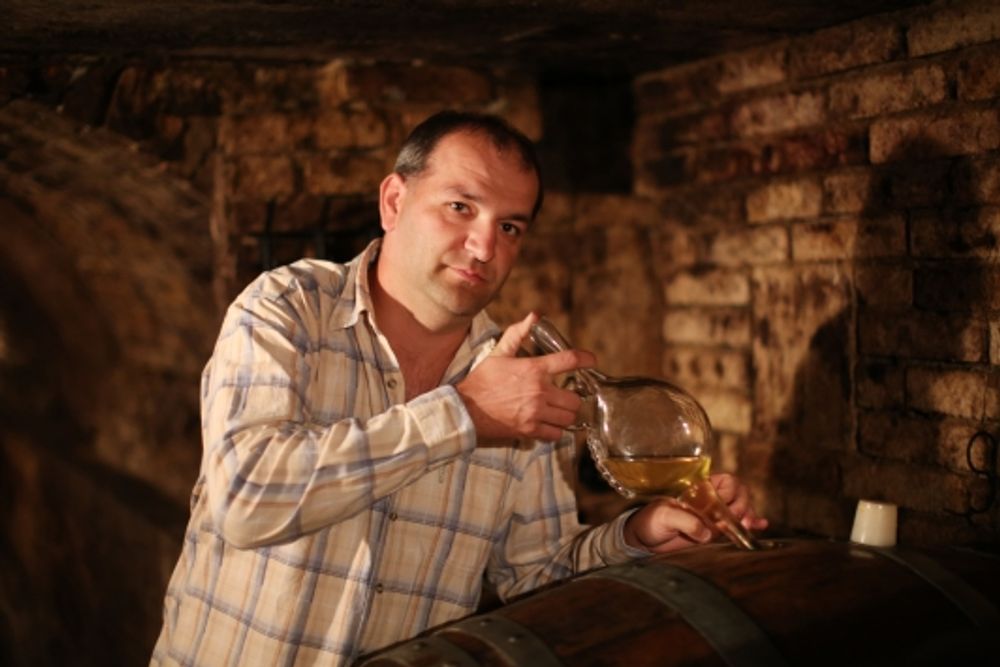
Zdeněk Vykoukal: many of the smaller wineries are growing fast
“There were basically only a few large, state-owned wineries plus thousands of small winemakers who made wine only for their own consumption. Now there are still some large scale industrial wineries, but also many midsize and small estates, with many of the smaller wineries growing into mid-sized ones with around 15-20 hectares,” says Zdenek Vykoukal, owner of the eponymous boutique winery in south Moravia.
The industry remains largely focused on the home market. This explains why much of the labelling is just in Czech and a relatively large number of wines are polosuche (half dry) rather than suche (dry) or are polosladke (semi sweet) and perlive (frizzante) reflecting local taste although, having seen the internationalisation of the Austrian and to a lesser extent Hungarian markets, many producers are increasingly focused on meeting international taste preferences.
A brief tour of South Moravia last year, based in the small wine town of Mikulov, reinforced my impression that the wine industry here is at a fascinating crossroads. So when the embassy offered to send some wines across, I received a cornucopia attesting just how diverse the Czech scene has become. World-beating Chardonnay, “old style” Sauvignon, Frankovka, and St Laurent were all there as were Veltlinske Zelene (Gruner Veltliner), Rzylink Vlassky (Welsch Riesling), Rzylink Rynsky (Riesling), Tramin Cerveny (Gewurztraminer) Pinot Noir and a number of sweet wines made from a range of the above varieties.
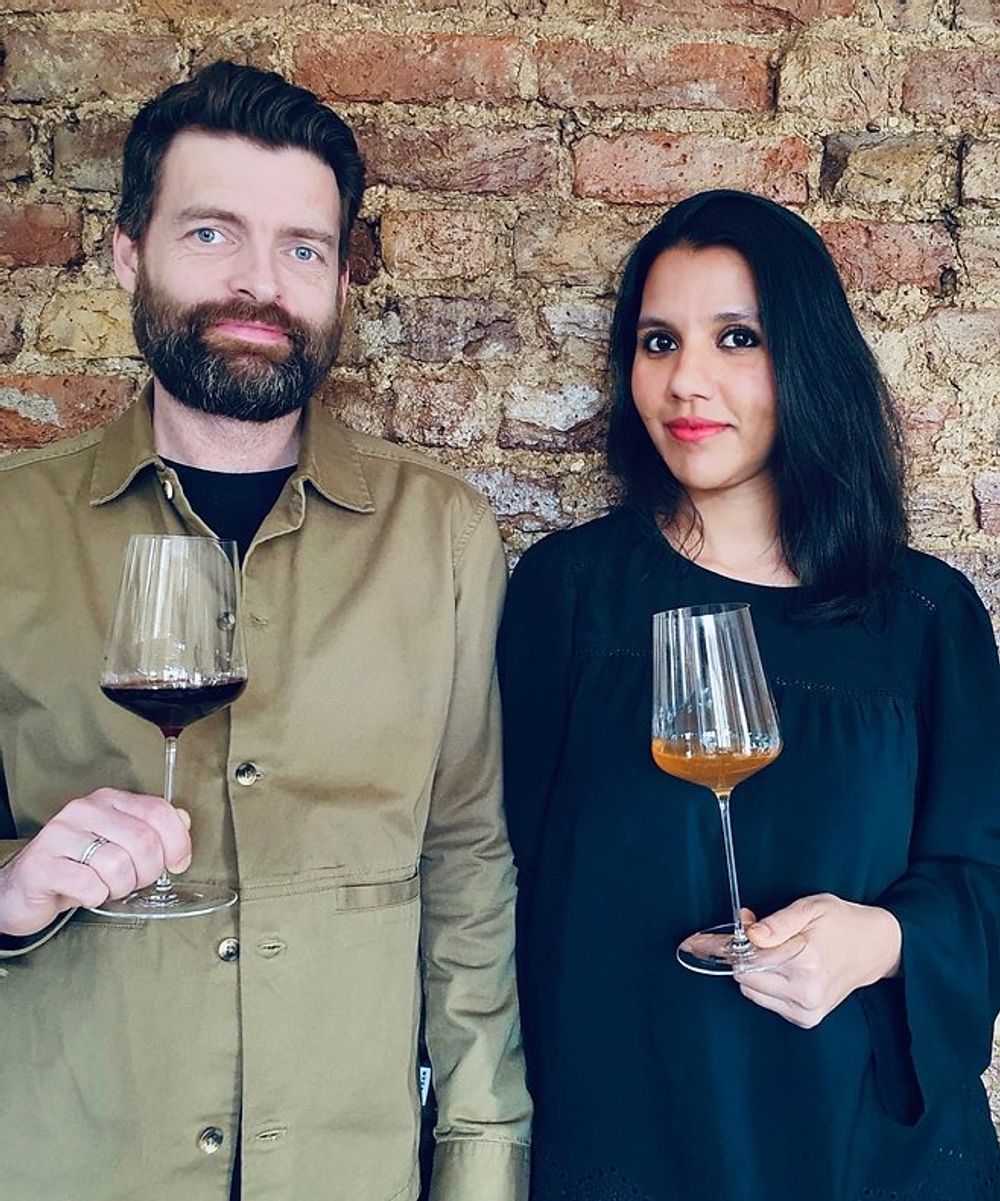
Jiří and Zainab from Basket Press
But there were also huge stylistic and quality differences reflecting ongoing structural changes within the industry, according to Jiri Majerik, who set up specialist Czechoslovak importer Basket Press Wines a few years ago.
“There is a divide when comparing conventionally-made wines from large wineries to wines from smaller winemakers who farm very differently – all organic, and achieve the right balance by being mindful about picking times, pruning, keeping biodiversity thriving – all of which all affect the quality and taste of the finished wines,” Majerik says.
Zdenek Vykoukal echoes this, saying quality has increased exponentially since around the year 2000 and the industry here and in Slovakia is now more modern than in Hungary – though not as advanced as Austria.
“There’s also more wine made in a natural (or authentic) way. Moravia is special in that that it produces a very wide array of different types of wines made from many grape varieties. The attraction of Moravian wines is their freshness and drinkability, which is harder to achieve in hotter southern countries,” Vykoukal says.
So which are the producers to look out for, and which are their best wines? Here are 13 producers making a splash in the home market and increasingly, abroad with a wide range of wines made from a big number of varieties, suggesting an industry with a great future.
The wineries to look out for from the Czech Republic
The Czech Republic is best known for its whites but from BV it was the reds that stood out for me.
The Andre 2015 is a gold medal winner and I can see why; medium weight with good acidity and dark berry fruit this really gives hybrids a good name. The Pinot Noir 2015 – comes in a hefty bottle as if to illustrate its seriousness – and is one of the best in the country; akin to a Pinot from Baden, lots of weight, dark forest fruit, good balance and acidity. And the Frankovka 2015 Reserva was a fine example of the grape, aged in French oak for 18 months, lots of fruit, fine tannins and wonderful balance. Memorable wines from a newish winery that is clearly going somewhere.
This leading producer seldom disappoints and the Malvasia 2017 was spot on. Just 11.5% this is very saline, herby, almond driven, quite unusual. And with a distinctive deep yellow colour.
A wide range of modern, screwcap wines from this family winery in central Moravia, close to the Morava River. Handpicked premium grapes probably explain the superior quality of their wines which include a delicious dry Rulandske Bile (Pinot Blanc) and a Hibernal (a German hybrid crowing between Seibal and Riesling).
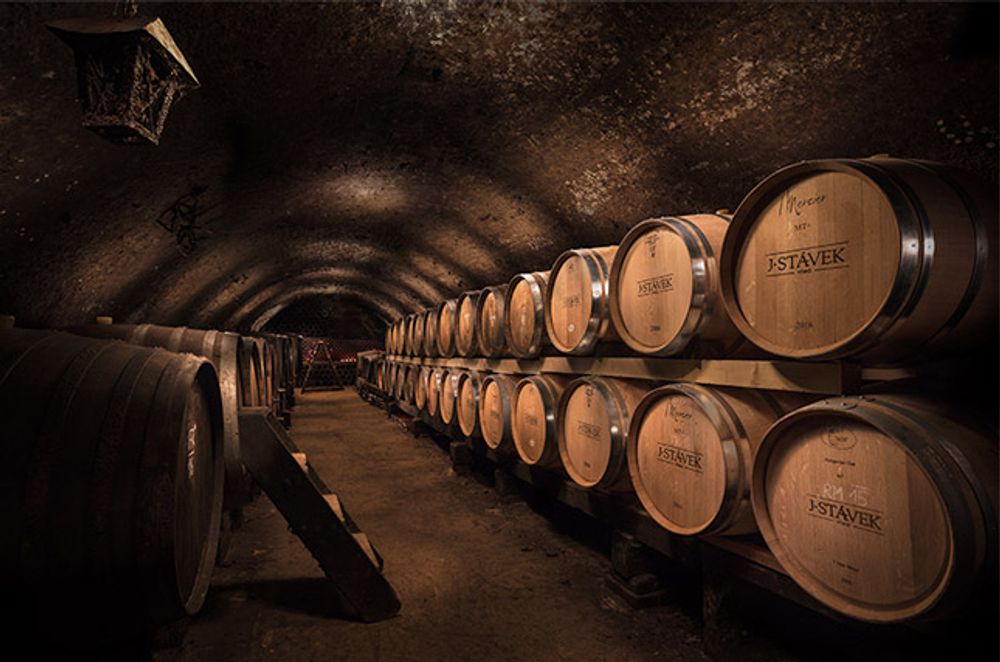
The oldest cellar in Němčičky
Stavek and Jedlicka
I’ve listed these two wineries together because the people running each are closely related and the wineries are two miles from each other in South Moravia (Bořetice, Němčičky). But what a fascinating contrast: Jan Stavek specialises in Frankovka generally – particularly as pink wines – and produces around 50,000 bottles, many of these made according to old traditional techniques. His Frankovka 2018 was a delicious, full bodied take on the variety which will evolve with further ageing.
Jedlicka is focused on red blends, although it also makes some single varietals. Total production here is around 150,000 bottles with an underlying philosophy that they “all as organic, clean and bio as possible.” Processing of the grapes is very sensitive & natural and maceration is very long.” The two 2015 Cuvees I tried – Tufary and Kacary – were delicious, medium weight, moreish and complementary. The former is a blend of Cabernet Sauvignon, Merlot and St Laurent, the latter of Pinot Noir, St Laurent and Andre, a local crossing of Frankovka and St Laurent. Lots of dark herby spice on the latter.
This winery is named after the Roman Emperor Marcus Aurelius who first established vines on the planes near Palavske Vrchy outside Brno, the same area today grows what many consider to be the best Riesling in Moravia. Lots of medals as the bottles show. The wines are off-dry, with a wonderfully rich golden colour. The winery also produces a second tier range of slightly frizante, off-dry wines including a pink Cabernet Sauvignon 2018 and a slightly drier Pinot Blanc (Rulandske Bile) 2018, both light at around 11% but perfect for lunch outside on a sunny afternoon.
Something of an outlier here; heavy Burgundy bottles, heavy wines – around 14.5% typically even for the Pinot Noir, and 15% for the Tramin – and mixed appeal. But these are interesting wines with quality improving all the time.
Nove Vinarstvi
If you want a big, oaky, full bodied Chardonnay akin to something from Napa or South Australia, look no further – the award winning Petanque Chardonnay 2016 made from grapes grown in limestone soil, is just for you. Surprisingly full-on for a cold climate wine-producing country, and at 13.5% abv, this is a great winter white.
Vinarstvi Pfeffer (Rakvice)
This relatively young winery, located in south Moravia around 40 minutes south of Brno, produce pretty much the full range of grape varieties including (oddly) a Kerner and a Moravian Muscat. For me though the star turn here is their Zweigeltrebe 2018 which is quite spicy, medium weight and herb-driven.
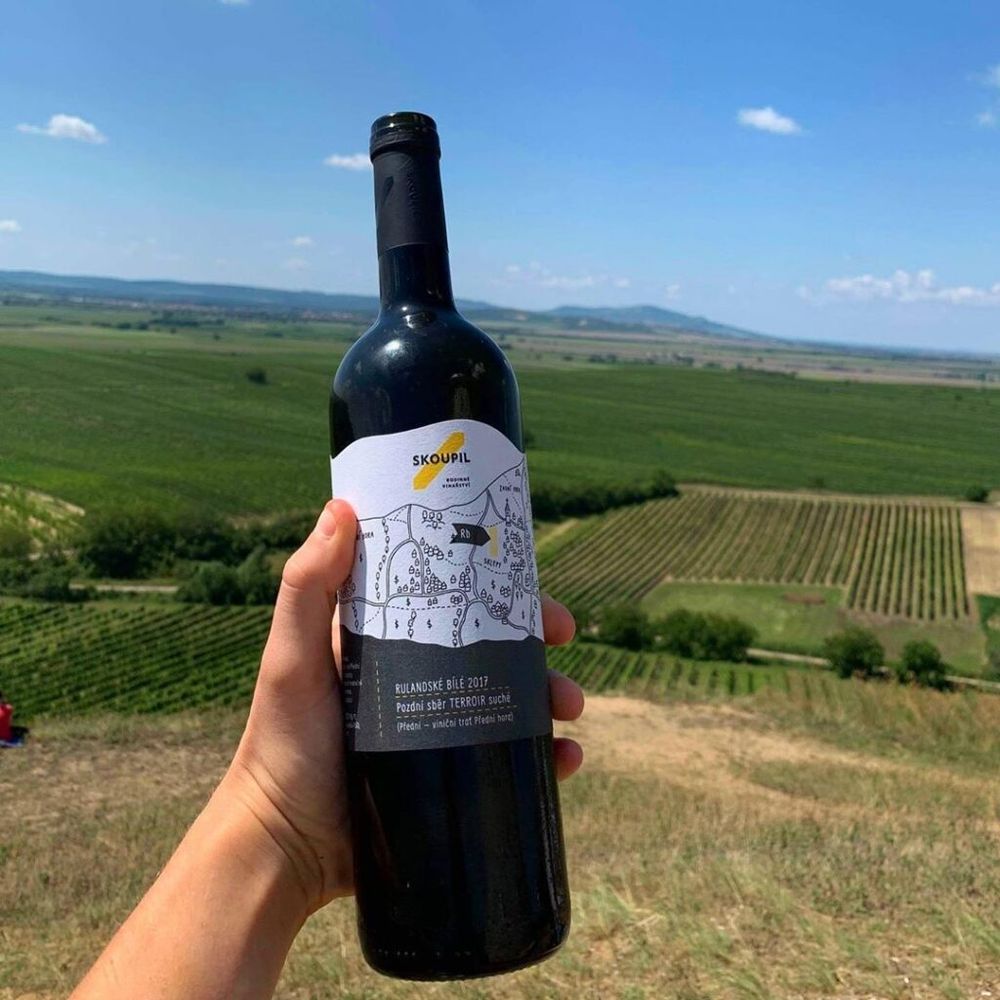
The star for me was the very moreish, slightly off dry, very young and fresh Frizzante Irsai Oliver 2019, a crossing more normally associated with Hungary. Very appealing.
Small high end winery established around 2003. The Pinot Noir Organic Reserve 2016 is quite full bodied, 13.5%, good fruit and structure. The Cremant de Spielberg Brut 2013 is a surprisingly old and quite impressive sparkler made from Chardonnay; quite ripe, walnut notes, good structure and acidity. Cabernet Cortis 2017 – at 14% this is quite a full-on example of this hardy, dark-skinned German bred grape, developed first in 1982 and mostly used for blending. This is very nice, with bramble and dark, blackcurrant flavours on the palate.
Based in Cejkovice, this is one of the Czech Republic’s oldest wineries and traditionally a supplier to Prague Castle. Reportedly founded in 1248 by the Knights Templar, it was re-established in the mid 1930s as a cooperative and today produces a wide range of around 5m bottles. Of its Mid-range quality wines, Sparkling Chardonnay 2018 Demi-sec is actually not too sweet, well made and refreshingly different. The limited edition Varietal Collection wines are pretty solid and well made. Chardonnay 2018 and Cabernet Sauvignon 2018 are both well-balanced with good fruit and acidity and alcohol levels of 13.5% and 13% respectively. But the winner here was the Diamond Collection Rulandske Bile 2018, a well-balanced smooth expression of Pinot Blanc with good fruit and texture.
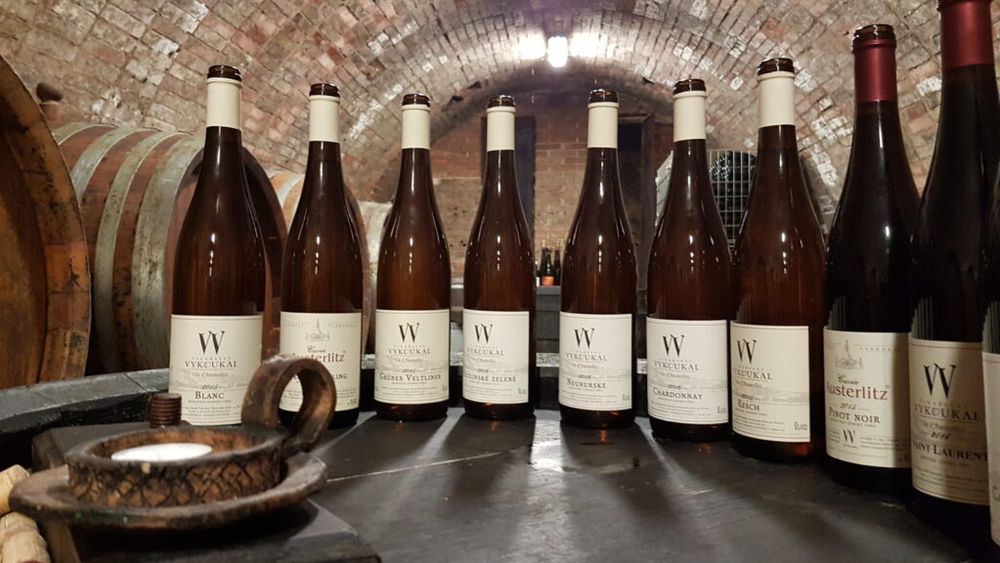
Small but ambitious winery located in the terroir of the famous 1805 battle against Napoleon at Slavkov u Brna just outside Brno. Owners say the terroir is unique.
The Vavrinecke (St Laurent) 2017 from Terroir Austerlitz, 12% was great, I must say. Rare crossed variety between PN and Savagnin, quite bitter, dark fruit, dry but soft warm tannins, quite appealing. Organic, very mineral, good salinity and low intervention.
The Ryzlink Rynsky 2018 – with a delightful green frog above the label, is fruit-driven, slightly off dry, light petrol notes, quite moreish. So too is the old fashioned Sauvignon Blanc retro style. SB as it used to be.































